
In the world of the “alternative” scholars, the Denisovans are a race of giant psychic shamans with problematic teeth, who can take credit not just for the Lost Civilization (aka Atlantis) but for the achievements of later human civilizations as well. They are the Nephilim, the giants of the Bible, the Annunaki, the culture-bearers, the wellspring of all wisdom and ancient lore. They’re pretty hot stuff in the world of the alternos.
Archaeologists and paleoanthropologists find all of that very surprising. In the academic world, the Denisovans are a long-extinct hominin line known from a handful of bones and teeth and—thanks to a happy accident of preservation— enough usable DNA to enable their contribution to the existing human genome to be tracked. They are a work in progress and an exciting new piece in the jigsaw puzzle of human origins, but it’s extremely unlikely they were giants, or psychic; their teeth were probably just fine, their culture and lifeways are as yet unknown, and they died out long before civilization became a thing. So where did all that other stuff come from?
Well, it seems to be another example of pseudoscience co-opting a genuine scientific issue, as we saw with the Lost Civilization community’s ecstatic adoption of the Younger Dryas Impact Hypothesis. Most of what the alternos attribute to the Denisovans, as far as I can tell, derives not from the archaeological evidence, but from a pre-existing alterno literature on giants, Nephilim, and so forth, onto which the Denisovans were grafted soon after they were first proposed in 2010. Ultimately, it seems that a certain Denisovan tooth is the key.
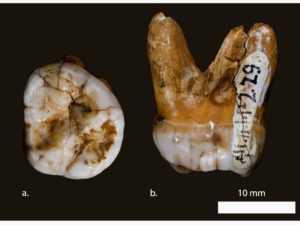
This is a left upper molar from an individual designated Denisova 4, a young adult male who lived in Siberia prior to 50K years ago. It’s a big tooth, outside the range of either Neanderthal or H. sapiens, and it has other archaic features as well. (See this article, pp.1058-9, for a description and analysis.) The alternos’ inference is that Denisova 4 must have been large-bodied in proportion to the tooth, which would make him a giant—and there you have it. But, alas for the alternos, tooth size is also related to function; the Denisovan molar nicely fits the size range of earlier hominin dentition, including that of teeny australopithecines standing under four feet tall. As the archaeologist Andy White puts it, “If tooth size was only related to body size, the robust australopithecines would have been large enough to eat the Denisovans for breakfast.”
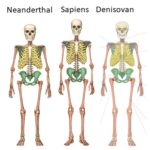
That, as far as I can tell, is the whole basis for linking the inoffensive Denisovans with mythical giants and mythical lost civilizations. In fact, estimates of their stature based on groundbreaking genetic extrapolation techniques have put them at about the same average height as the Neanderthals, a little shorter than Upper Paleolithic H. sapiens. The rest comes down to a familiar pattern of unsupported inference, misrepresentation of scientific research, and wishful thinking. Two other factors, which I’ll look at in the rest of this article, are the failure to check primary sources, and the common-or-garden reading fail.

First, though, I must point out that I am standing on the shoulders of (ahem) giants. Much pseudoarchaeological literature makes an effort to link the Denisovans, or Denisovan/sapiens hybrids, with the curious genre of 19th-century newspaper reports of giants excavated in Native American mounds, often with claims of supernumerary teeth. The afore-mentioned Andy White has commented extensively (and often hilariously) on these, while the indefatigable Jason Colavito has catalogued and critiqued a large number of such reports, and will shortly be bringing out a book on the era of the Moundbuilders. Spoiler alert: the reports of giants are mostly hoaxes, misunderstandings, or the 19th-century equivalent of clickbait. I want to look at how primary sources are handled in a fairly typical example of the Denisovan-shaman literature.
Andrew Collins is a prominent British alterno with a strong belief in the Denisovans as giants, savants, and culture-bearers who came to the Americas many millennia ago and interbred with Native American populations. The best thing I can say of him is that he does, he really does, try to take account of archaeological evidence; unfortunately, he does it very badly. He either does not read the primary sources with adequate comprehension, or he relies on secondary sources, some of which have pre-mangled the information. Fine examples are found in his paper “The Coming of the Giants: Rise of the Human Hybrids,” originally published in 2014 and currently available on his website.
Collins claims that the Denisovans/hybrids in the Americas can be distinguished by three major traits, not necessarily all together. First, their remains may have received special treatment on burial, implying they had elite or special status. Second, they were giants, or at least quite tall (Collins defines the term “giant” flexibly). Third, they displayed hyperdontia, extra teeth, in some cases a full extra set. Here are some examples of how Collins deals with his sources.
Collins: Those readers familiar with stories relating to the discovery of giant skeletons in the United States will be familiar with this disorder [hyperdontia], as there are various accounts of oversized human skeletons where the skulls have been found to contain a “double row of teeth” in one or both jaws (for example, see Bancroft, 1882, IV, 694-5, relating to giant skeletons found in caves on San Rosa Island, California, “furnished with double teeth all the way round the jaw,” and Weston, 1906, 400, regarding a giant skeleton found in Middleboro, Massachusetts, with “a double row of teeth in each jaw”.
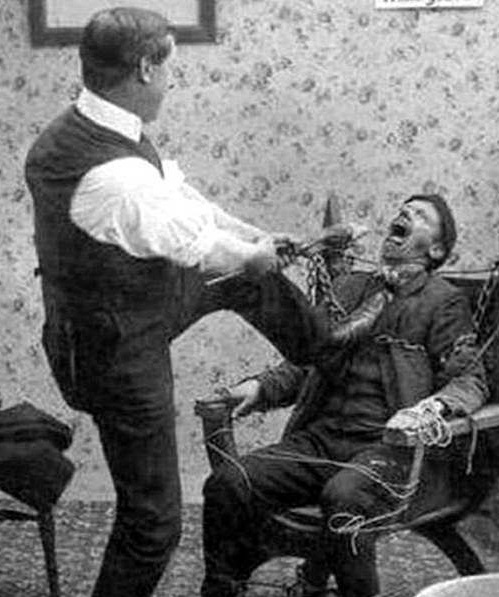
First, Andy White has convincingly shown that phrases like “double teeth all around the jaw” are usually a recent misunderstanding of a 19th-century idiom signifying nothing more than “this guy had all his teeth.” In a century when teeth were notoriously bad and extraction was the primary way of dealing with toothache, a full set of gnashers would indeed be worthy of its own idiom. But if you examine the sources cited in that paragraph, other problems emerge.
Bancroft (1882) retails an 1861 report from Santa Rosa Island (not San Rosa) describing numerous complete skeletons and skulls in the caves, adding “[s]ome very wonderful skulls are also reported as having been found on the islands, furnished with double teeth all the way around the jaw.” There is no mention of the skeletons being oversized. However, Bancroft’s next paragraph continues:
“Miscellaneous reports on authority varying from indifferent to bad…are as follows: In 1819 an old lady saw a gigantic skeleton dug up by soldiers at Purisima on the Lompock rancho…Taheechaypah pass and the mission of San Buenaventura are other localities where skeletons of extraordinary size have been found.”
No mention of teeth. Collins (or his source) conflates skeletons with fabulous teeth reported in one area, with some very dicey tales of oversized skeletons in nearby areas, to produce the hyperdontic giants of San (sic) Rosa. I would call this a reading fail.
The second example is really quite funny. Collins’ “giant skeleton found in Middleboro, Massachusetts, with ‘a double row of teeth in each jaw’” (Weston 1906:400) turns out to be that of an 17th-century settler named Mr. Richmond, “a man of gigantic stature, bold and fearless…and much feared by the Indians.” When his bones were later dug up in the course of roadworks, his thigh-bone measured 4” longer than normal, and he had “a double row of teeth in each jaw” – but with his European ancestry, he could hardly be regarded as a Denisovan hybrid or psychic shaman. It is hard to believe that Collins checked the primary source that he cites.
Collins’ major example, taking up nearly a quarter of the paper, is Burial 37 from Blossom Mound in California, a cemetery of the Windmiller culture, 4350-3000 BP. This unfortunate individual, who died between the ages of thirty and forty, suffered from acromegaly, a hormonal disorder that causes bones to continue growing in adulthood, plus a host of complications. Also, his teeth were funny. The primary source Collins refers to is Bartelink et al, 2014, which is not an excavation report, but an analysis of Burial 37’s skeletal pathologies and a diagnosis of probably acromegaly. However, most of Collins’ information appears to be derived (rather selectively) from a secondary source, Pastino 2014, quoting an interview with Dr. Bartelink.
To summarize Collins’ claims about Burial 37:
1. His burial was unique on the site, indicating “a different journey ahead of him in the spirit world.” The distinctions were:
“a rich array of grave goods…including forty-eight beads fashioned from shells of the Olivella sea snail, seven ornaments carved from the shell of the abalone mollusk and an obsidian projectile point. What is more, his body was laid outstretched and face up, his head to the north, whereas the other 176 internees of the grave mound lay face down, their heads to the west. Some time after interment, Burial 37’s skull was removed and placed at over his left ankle…”
A quick check of the available excavation reports shows that Collins should have made a quick check of the excavation reports. While the majority of the burials were face-down with heads to the west, about 25% were face-up, and head direction varied from west to northwest and even east. Burial 37’s grave goods (shell beads and an obsidian point, plus red-ochre staining, which Collins does not mention) were standard for male burials, especially face-up male burials, but his array was not particularly rich. Compare his modest wealth with that that of nearby Burial 33, who took with him 885 Olivella beads, seven abalone ornaments, a chert scraper, and a quartz crystal; or with Burial 62, who boasted fourteen points, five crystals, 46 Olivella beads, 391 abalone beads, and four abalone ornaments.
According to Bartelink et al, the skull was most likely disturbed after the soft tissues had decomposed, possibly when an adjacent grave was being dug; in fact, quite a bit of the skeleton was not recovered, suggesting the burial had been disturbed and the position of the skull was not significant. In short, there was nothing in Burial 37’s circumstances to set him (or his journey in the spirit world) apart from the other burials in Blossom Mound.
2. Burial 37’s acromegaly and hyperdontia suggest he was a hybrid or a throwback expressing Neanderthal traits.
“Colllins: [C]ompared against fourteen other skulls examined from the mass grave (sic), that of Burial 37 was taller and wider. The skull also possessed a heavy brow ridge, while the body had unusually thick arms and legs, traits that are unusual in modern humans, but are common in Neanderthal anatomy. In addition to this, he had an elongated chin, resulting in a “lantern” jaw, along with a pronounced nose giving it a beak-like appearance (Bartelink, Pastino, 2014). On top of this, the bony pocket in the skull that holds the pituitary gland, which is called the sella turcica as it looks like a Turkish saddle, was significantly enlarged.”
While admitting that Burial 37 was not a giant—he stood about 5’5” tall—Collins still somehow finds him relevant to the hyperdontic-giant Denisovan thesis. However, Collins suggests Burial 37’s peculiar features reflect Neanderthal ancestry, even as he correctly tells the reader that most cases of acromegaly result from a pituitary tumour. But how Neanderthal-ish was Burial 37?
Not very. A Neanderthaloid skull would be lower and more sloping, not higher. There is acromegalic thickening of the occipital bone, but no suggestion of the occipital bun characteristic of Neanderthals. And, whereas a Neanderthal skull would be uniformly robust, Burial 37 actually shows a thinning of the parietal bones, which can be a side effect of acromegaly.
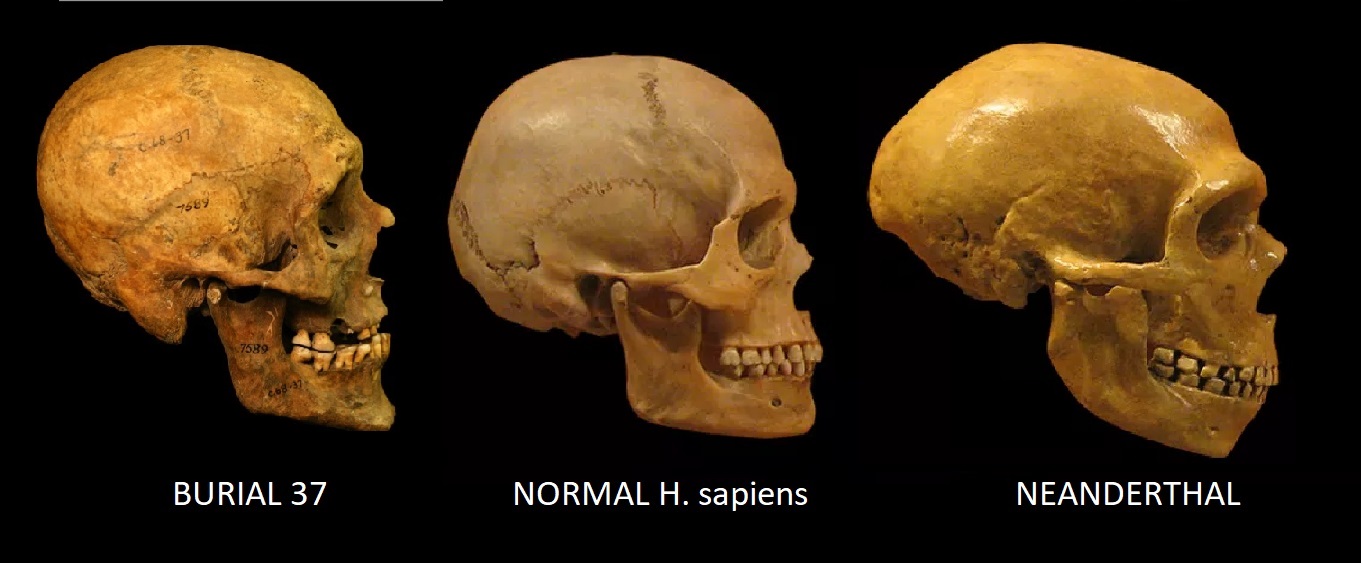
Burial 37 had significant bone deposition above the eyes, but nothing like a heavy Neanderthaloid brow ridge. The “lantern jaw” was absolutely not a Neanderthal trait; our cousins’ chins sloped backwards, whereas H. sapiens chins have a projection called the mental eminence, which was present and exaggerated in Burial 37. The original report does not mention unusually thick arms and legs, though it lists localized “signs of periosteal bone deposition at several enthesis sites,” that is, areas where ligaments and tendons attach to the bone. The enlargement of the sella turcica would be expected in acromegaly, linked to the pituitary tumour at the root of the condition. And then there’s the teeth:
Collins: One of the most significant points about the skull of Burial 37 is the mis-growth of the eye-tooth, or canine, which is upside down and protruding through the bone just beneath the nose. Although this abnormality can be explained as the effects of acromegaly, the presence of supernumerary teeth in a person is more correctly known in the dental profession as hyperdontism.
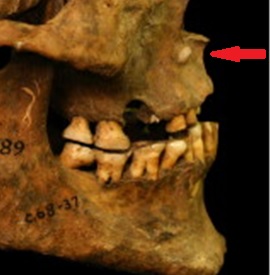
Alas, poor Collins. The tooth in question is not supernumerary, it’s just inverted, and its normal position has been taken over by the right upper first molar. The unfortunate Burial 37 had terrible teeth, including crowding and malocclusion that may be attributed to acromegaly, but he was not hyperdontic. This is not only clear from the primary source, but Dr. Bartelink was kind enough to confirm it in a personal communication. In summary, the hyperdontic Neanderthaloid who took up nearly a quarter of Collins’ article was neither hyperdontic nor Neanderthaloid. He wasn’t a giant, either. So why was he there at all?
I could go on and on. Every source that Collins referenced in this paper was either misrepresented, misunderstood, or mangled at the outset. The irony is that H. sapiens did interbreed with Denisovans, Neanderthals, and possibly other non-sapiens hominins, but not in the ways and times that Collins and others of his ilk would have us believe. His tall, wise Denisovans disseminating ancient wisdom (and Denisovan sperm) to archaic Native Americans is a fantasy shored up with shoddy research.

Further reading: A special number of the SAA Record (Magazine of the Society for American Archaeology) includes relevant discussions of genetics in archaeology, early America, pseudoarchaeology, and other relevant issues. And believe me, these guys do check their sources.
Acknowledgements: special thanks to Dr. Eric Bartelink and Dr. Susan Pfeiffer for generously sending me copies of their publications.
Note: I did promise to continue answering Scott’s excellent questions in the next post, but ran across Collins’ paper and got entertainingly sidetracked. Normal programming will be resumed.
